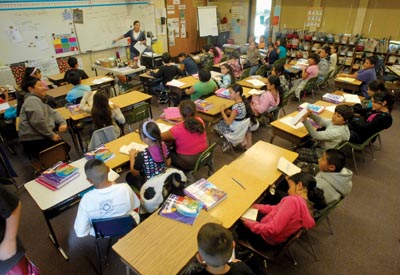Upwards of 500 students and their families might have no other
public school choice locally than to attend classes within the
Hollister district, now that its trustees have approved the new
policy limiting interdistrict transfers.
Spring Grove School parent Erin Livingston has one child graduating eighth grade this year and another who is in the fifth grade. She and many other parents whose sons and daughters transfer out of the Hollister School District “were taken aback” by a new policy that would bar most of their kids from returning to their familiar campuses, teachers and friends.
“I won’t be bullied back to the Hollister School District,” said Livingston, who is among an organized group in opposition to the change.
Livingston called the Hollister board’s move “arbitrary and underhanded” and said regardless of the outcome, she will not send her fifth-grade child to any schools in the city district next year.
“Emotionally, we’re concerned,” she said. “Academically, we’re concerned. Spring Grove is a California Distinguished School. Our kids deserve to ride it out.”
Upwards of 500 students and their families might have no other public school choice locally than to attend classes within the Hollister district, now that its trustees have approved the new policy limiting interdistrict transfers.
The policy, agreed to at the most recent board meeting, will lay out a set of more transparent guidelines for applicable families and limit the total number of outside transfers to 1 percent of the district enrollment, or 75 students, whichever is greater. Trustees made the decision in mid-February, while a group of residents in opposition have formed and is expected to attend Tuesday’s scheduled board meeting to speak out against it.
One of the main points of contention, beyond the basic argument in favor of choice, is that the Hollister district’s policy does not grandfather in students already transferring out – meaning a large majority of those students will be forced to change schools next year.
That decision comes after years of continual enrollment declines for Hollister, as many families have chosen to have their kids attend other, often higher-performing schools such as Spring Grove and Southside. Parents in the Hollister district have had such flexibility because it is designated as a “district of choice.”
Its drop in enrollment is directly tied to the Hollister School District’s recent financial troubles. It had to cut $6.5 million last year and another $5.5 million this year, and it faces a potential state takeover. Each student in the state’s “average daily attendance” formula amounts to about $5,000 in funding for the district, and there are now about 600 students in any given year transferring out of the Hollister district.
New trustee Joe Navarro, a recently retired teacher from the Hollister district, underscored how the policy change is focused on adding revenue to the coffers, and he pointed to the steadily increasing class sizes as a particular problem that needs solving.
He said he understands why parents might feel their “rights are infringed upon” but added that he has confidence in the district’s teaching staff and noted how his own daughter attends Sunnyslope School.
“We’re trying to deal with the whole picture,” Navarro said. “Unfortunately, funding has a lot to do with it.”
With such a large number of Hollister students affected, though, there will be a major impact on surrounding districts that have taken in those kids. Spring Grove School in the North County Joint Union School District has accepted an increasing number of students in recent years. This year, transfers from Hollister and other districts make up 42 percent of enrollment, said Jennifer Bernosky, the principal and superintendent.
North County is not a district of choice itself, but there isn’t nearly as much demand to transfer out of the district, which customarily scores well on standardized testing.
“Of course, we want to keep our students,” Bernosky said. “The biggest thing, I think this change is going to be very tough for the community. We have kids who have been at Spring Grove School since kindergarten.”
Over at Southside School, Principal and Superintendent Eric Johnson was particularly critical of the lack of retroactivity for current students and he pointed to a state law that he contends bars such a policy.
That law – AB 2444 – notes how a “pupil who has been granted an interdistrict transfer does not have to reapply” but it also says districts of residence can “rescind existing transfer permits if it receives a qualified or negative fiscal certification.” Hollister’s district last year received such a certification from the state due to its financial struggles.
From a logistical perspective, though, Johnson emphasized how districts plan for enrollment by investing in resources, such as teachers, furniture and supplies. He called the change “very disruptive” and mentioned how Southside officials plan to work with Hollister on the matter.
“We have to look out for kids first,” he said. “In this case, we’re not looking at that right now.”
Livingston, the Spring Grove parent, believes the main issue is continuity of education for the students. The Hollister district, she said, must realize that parents have sought other options for a reason.
“You don’t just yank the rug from underneath these kids,” she said.
If the policy does stand, though, Hollister Superintendent Gary McIntyre will have discretion in choosing eligible students who can transfer out, based on the set criteria. McIntyre did not immediately return phone calls seeking comment.
There are 10 guidelines laid out in the policy, such as transferring to meet childcare or health needs, having a sibling in another district, and written evidence that the family plans to move into the other district. Families must apply by no later than 4 p.m. April 15, according to a letter sent to parents.
Policy excerpt:
“The Superintendent or designee may deny an interdistrict attendance permit because of overcrowding within district schools or limited district resources or if an excessive number of students transferring out of the Hollister School District would cause the District financial hardship. Transfers out of the Hollister School District shall not exceed 1% of average daily attendance (ADA) … or 75 pupils, whichever is greater unless authorized by the Hollister School District Board of Trustees, and shall be apportioned if necessary among receiving districts by the Superintendent or designee.”
For more:
The opposition group has started a Facebook page here.
Demographics by year
2010
Hispanic: 3,059
White: 921
Socioeconomically disadvantaged: 2,622
English learners: 1,633
2009
Hispanic: 2,990
White: 993
Socioeconomically disadvantaged: 2,536
English learners: 1,576
2008
Hispanic: 2,888
White: 1,047
Socioeconomically disadvantaged: 2,404
English learners: 1,551
2007
Hispanic: 2,921
White: 1,126
Socioeconomically disadvantaged: 2,420
English learners: 1,557
2006
Hispanic: 2,947
White: 1,231
Socioeconomically disadvantaged: 2,394
English learners: 1,525
2005
Hispanic: 2,853
White: 1,342
Socioeconomically disadvantaged: 2,300
English learners: 1,406
2004
Hispanic: 2,759
White: 1,465
Socioeconomically disadvantaged: 2,043
English learners: Unavailable
Source: API statistics
Test Scores 2009-10 API
Hollister School District: 760
Spring Grove School: 830
Southside School: 894










